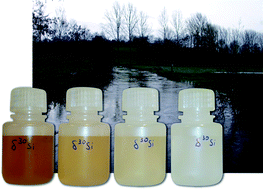Controlling the mass bias introduced by anionic and organic matrices in silicon isotopic measurements by MC-ICP-MS
Abstract
One of the most widely used

* Corresponding authors
a
Dept. of Earth Sciences, Royal Museum for Central Africa, Tervuren, Belgium
E-mail:
harold.hughes@africamuseum.be
b Dept. of Earth and Environmental Sciences, Université Libre de Bruxelles, Brussels, Belgium
c Dept. of Analytical and Environmental Chemistry, Vrije Universiteit, Brussel, Belgium
One of the most widely used

 Please wait while we load your content...
Something went wrong. Try again?
Please wait while we load your content...
Something went wrong. Try again?
H. J. Hughes, C. Delvigne, M. Korntheuer, J. de Jong, L. André and D. Cardinal, J. Anal. At. Spectrom., 2011, 26, 1892 DOI: 10.1039/C1JA10110B
To request permission to reproduce material from this article, please go to the Copyright Clearance Center request page.
If you are an author contributing to an RSC publication, you do not need to request permission provided correct acknowledgement is given.
If you are the author of this article, you do not need to request permission to reproduce figures and diagrams provided correct acknowledgement is given. If you want to reproduce the whole article in a third-party publication (excluding your thesis/dissertation for which permission is not required) please go to the Copyright Clearance Center request page.
Read more about how to correctly acknowledge RSC content.
 Fetching data from CrossRef.
Fetching data from CrossRef.
This may take some time to load.
Loading related content
